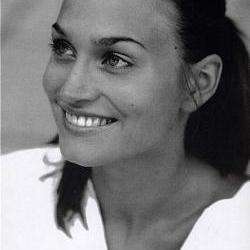In her debut as an opera director, dancer and choreographer Marlene Monteiro Freitas follows exactly the approach to Berg’s unfinished masterpiece that her biography might suggest. The result, while interesting and expertly executed, manages to take an opera bursting with sex, death, seduction and drama and deconstruct it into an endless series of unconnected, stylized choreographic bits and unrelated objects littering the stage (designer Yannick Fouassier), from saddles and benches to microphones and stools. If Lulu is not buried alive, it is certainly left completely unrecognizable; fundamentally splintered into a thousand shards of rhythmic minutia and abstracted, unrelated movement.
Let’s focus first on the interesting and the expert, which includes the talents of every singer and dancer on stage and the ORF Radio-Symphonieorchester Wien, irreplaceable musically, but physically transported from their standard place in the pit to a lofted section above the stage focus. Conductor Maxime Pascal, costumed with the entire cast in white shirts/blouses, black pants and bright blue shoes, was an active agent in the choreography. A toss of a coin at the top of the show sealed his fate, to cue the overture, and his raised white podium-cum-airplane stairs also housed the death of Dr Schön and gave Lulu the chance to mime conducting.
Vocally, the title role was masterfully sung by Vera-Lotte Boecker, whose voice is as brilliantly improbable as the character of Lulu herself. Boecker was the picture of dispassionate clarity and ease throughout, with even the whistle tones completely connected to her core and under remarkable control. This uncanny detachment was by design – after Lulu’s first husband, Dr Goll (Franz Tscherne) passes away, she photographs his fingers like a world-weary journalistic pathologist, her doll-like face revealing nothing. The sole suitor who matters to her, Dr Schön, was sung by Bo Skovhus, who not only performed powerfully but acted hard enough to impress as a character instead of a figure though choreography designed to do the opposite. The rest of the cast, including Cameron Becker (Der Maler), Edgaras Montvidas (Alwa), Kurt Rydl (Schigolch) and Anne Sofie von Otter (Gräfin Geschwitz) were likewise vocally present, but could hardly register as characters in any traditional sense; the same goes for Katrin Wundsam, Martin Summer and Paul Kaufmann.
The movement artists, Francisco Rolo, Henri “Cookie” Lesguillier, Ina Wojdyla, Joãozinho da Costa, Kyle Scheurich, Nina Van der Pyl, Rui Raixão and Tomás Moital, were meticulously directed to perform awkward, wind-up creature types of movements on loops. They contorted, ringed their mouths with shaving cream, and used their blue or green-gloved hands to transform into imaginary monsters to the point that by the end I was exhausted for them. What was it all about is a question for the gods. Neither reflecting the characters inner lives, nor telling the story in a perceptible way, their movement simply underscored the more jittery aspects of Berg’s complex score. They performed a great deal of virtuosic movement that ran on a parallel track to Frank Wedekind's twin Lulu plays on which the libretto is based.
Sadly, because this was a collaboration between MusikTheater an der Wien and the Wiener Festwochen, the audience was packed primarily with Lulu non-initiates. If those of us who eat opera for a living had no chance of identifying this cut of meat, those unfamiliar with Berg’s psychological juxtaposition of the femme fatale non plus ultra / fragile victim within the petty bourgeoisie setting of fin de siècle Vienna could hardly leave satisfied that they understood the work, portrayed by abstracted figures who prohibitively avoid directly interacting.
The cherry on top was the final extended scene. Instead of performing Friedrich Cerha's reconstruction of the unfinished third act (standard since its introduction in 1979), music from Berg’s Lyric Suite accompanied the final scene and a hitherto unseen character, a miniature figure dressed completely in white, tea towel on her head, masked in garish makeup and missing part of an arm, who moves as painfully slowly as possible from the back of the stage to the front, attended by a man in black. Is this an allusion to Lulu being brought low but still stumbling to the altar, the continuous projection of desire by man after man? Or an allusion to her gruesome demise, “helped on” by Jack the Ripper? Who knows. It was a question I might have asked had I attended the audience Q and A following the performance, but if a production concept is incomprehensible after nearly three hours and extensive program notes, I simply cannot bring myself to invest more of my time into it.




